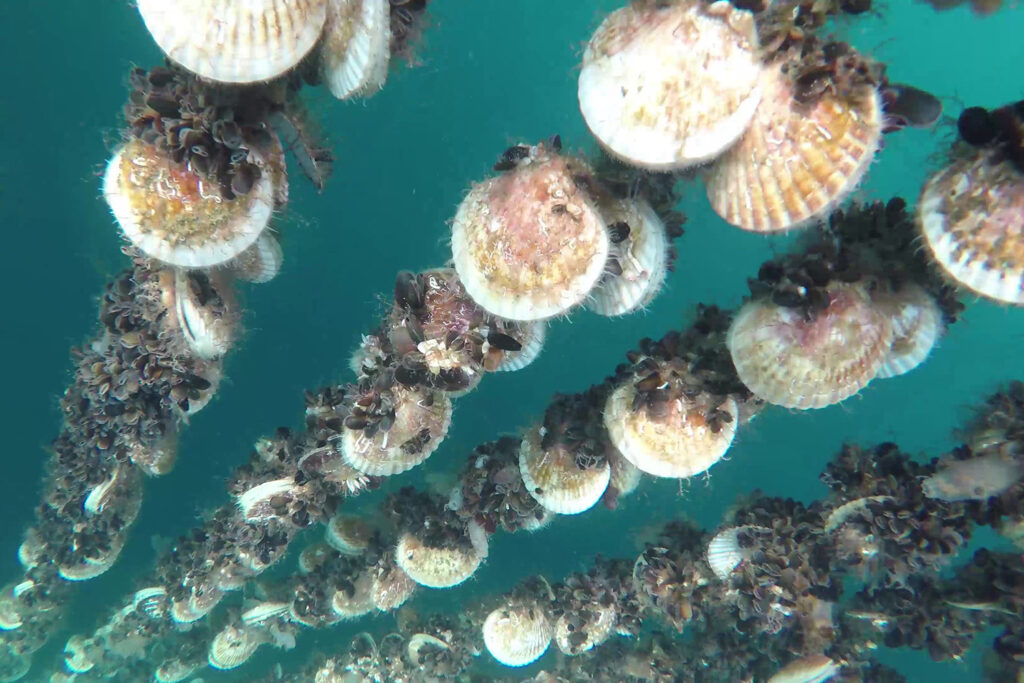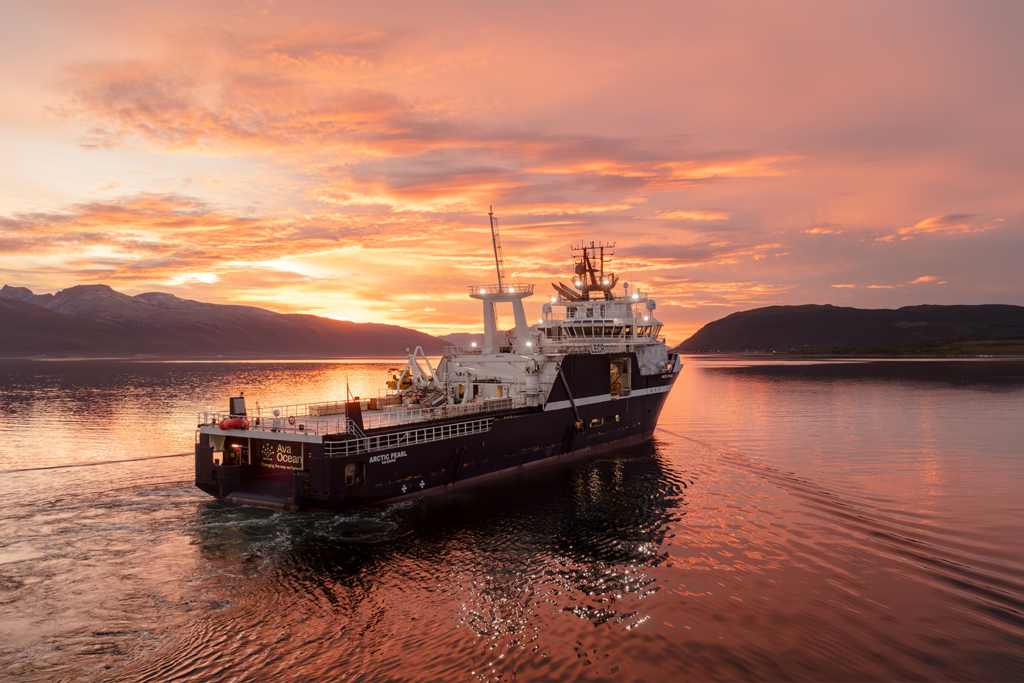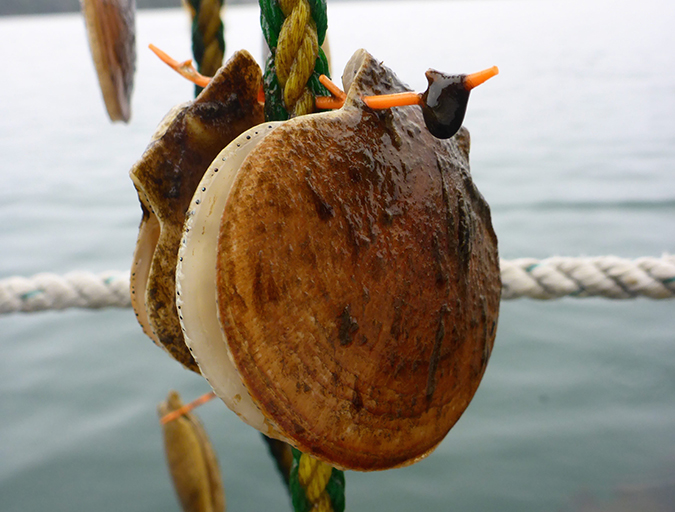UMaine study shows ear-hanging boosts scallop farming efficiency and value, offering Maine growers a path to scale up sustainably

A new study from the University of Maine’s Aquaculture Research Institute (ARI) and Darling Marine Center is refining best practices for cultivating Atlantic sea scallops (Placopecten magellanicus), a species gaining traction in Maine’s growing aquaculture sector.
The study, published in Aquaculture, compares two commonly used grow-out methods – ear-hanging and lantern net culture – across a full production cycle. The research offers valuable insights into how each technique affects scallop size and adductor muscle weight, a key determinant of market value. Findings provide commercial growers with data-driven guidance for optimizing scallop yields and improving overall production efficiency.
Maine’s scallop aquaculture industry is still emerging, and growers are looking for scalable, efficient production methods. Suspended culture – typically using multi-tiered lantern nets – is the most common approach, but it requires frequent maintenance to manage biofouling, which can hinder growth and increase labor. As the industry expands, reducing these burdens is key to improving efficiency and profitability.
An alternative approach, ear-hanging – adapted from Japanese scallop farming – may offer some advantages. This method involves drilling a small hole near the shell hinge and suspending each scallop individually on a line. The increased spacing allows for better water flow, which could enhance growth and reduce the need for maintenance.
To compare the two methods in real-world conditions, researchers partnered with commercial farms in Penobscot Bay and Frenchman Bay. Over four years, they tracked scallop growth and adductor muscle weight – the primary marketable product in U.S. seafood markets – to assess performance and commercial viability.
The study found that scallops cultured using the ear-hanging method achieved slightly larger shell heights – about 1 to 4 percent greater than those grown in lantern nets. More notably, ear-hanging scallops had up to 12 percent more adductor muscle weight. Since the adductor muscle is the primary product sold in U.S. seafood markets and fetches a higher price when larger, this increase represents a meaningful advantage for growers focused on maximizing market value and profitability.
“We wanted to provide growers with data they could actually use on the water,” said Christopher Noren, doctoral researcher at UMaine and lead author of the study. “By comparing these two methods across a full grow-out cycle, we were able to identify where the biological advantages lie and how they might translate to better yields and more efficient operations.”
The results also highlight the role of temperature in scallop growth. Ear-hanging scallops grew more quickly in optimal conditions, which are between 50- and 59 degrees-F, but were more affected by colder winter temperatures than those in lantern nets.
“These findings give scallop farmers a clearer picture of how different methods impact growth and harvest timing,” said co-author Damian Brady, a professor of oceanography at UMaine. “Understanding the trade-offs between techniques will help inform decisions about production strategies.”
The United States relies heavily on seafood imports, including scallops. As interest in homegrown scallop aquaculture rises, research like this provides Maine farmers with the data they need to refine techniques and improve profitability. By identifying methods that optimize both growth and labor efficiency, UMaine researchers are helping lay the groundwork for a more sustainable, commercially viable scallop aquaculture industry in the Gulf of Maine.
“This research gives us real-world numbers to work with,” said Andrew Peters, owner of Vertical Bay LLC and co-author on the study. “Understanding how small changes in gear choice impact growth and market value helps us make smarter decisions as we scale up scallop farming in Maine.”
Now that you've reached the end of the article ...
… please consider supporting GSA’s mission to advance responsible seafood practices through education, advocacy and third-party assurances. The Advocate aims to document the evolution of responsible seafood practices and share the expansive knowledge of our vast network of contributors.
By becoming a Global Seafood Alliance member, you’re ensuring that all of the pre-competitive work we do through member benefits, resources and events can continue. Individual membership costs just $50 a year.
Not a GSA member? Join us.
Author
Tagged With
Related Posts

Intelligence
Could AI-powered image recognition be a game changer for Japan’s scallop farming industry?
Researchers in northern Japan are using an AI image-recognition technique to observe scallop populations in lantern nets.

Innovation & Investment
Norway banned scallop harvesting in the Barents Sea. Responsible Seafood Innovation Award finalist Ava Ocean delivered a tech solution.
Ava Ocean proves scallop harvesting in the Barents Sea can be done responsibly using its selective “shellfish picker" technology.

Responsibility
Study: Ocean acidification and ocean warming hinder juvenile Atlantic sea scallop growth
Researchers find that ocean acidification conditions projected between now and 2100 would hinder the growth of juvenile Atlantic sea scallops.

Innovation & Investment
Maine scallop farmers get the hang of Japanese technique
Thanks in part to a unique “sister state” relationship that Maine shares with Aomori Prefecture, a scallop farming technique and related equipment developed in Japan are headed to the United States. Using the equipment could save growers time and money and could signal the birth of a new industry.



